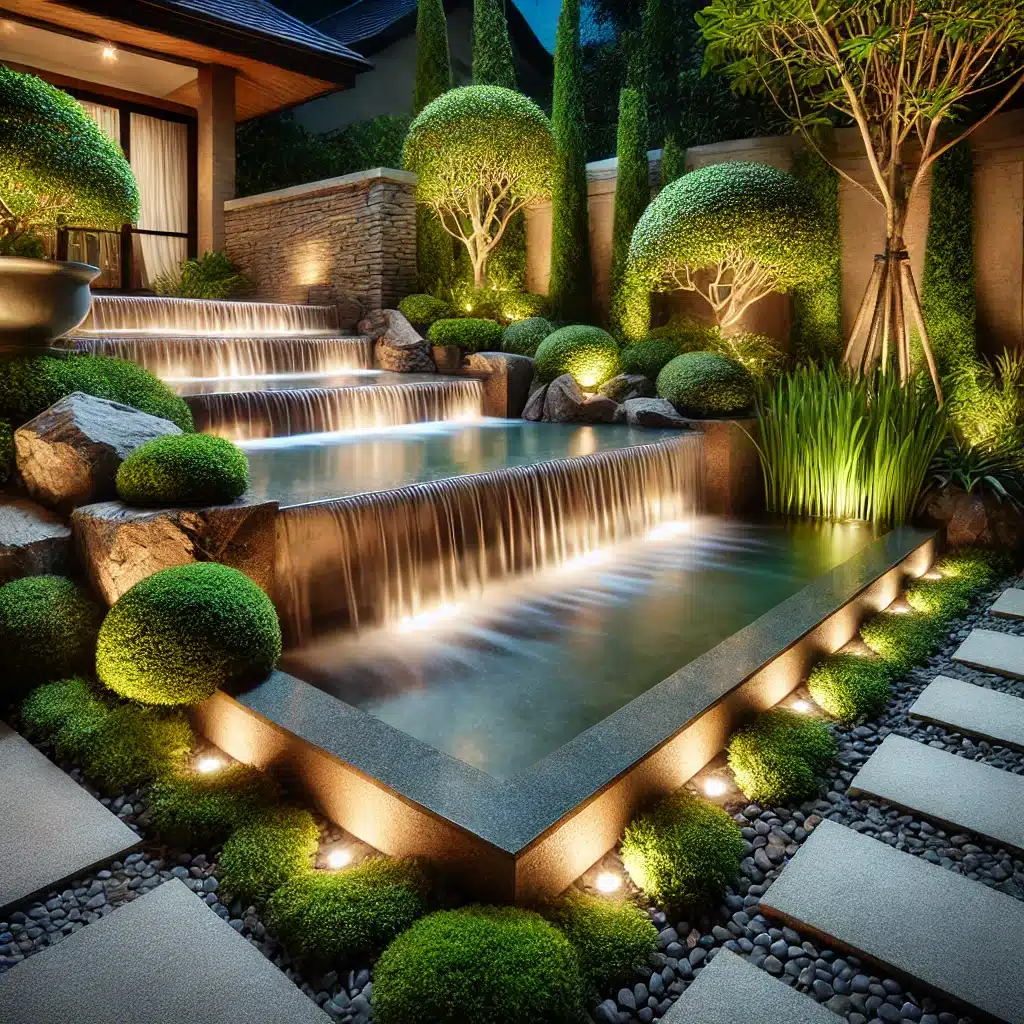As a landscape architect with over a decade of experience, I’ve witnessed firsthand the remarkable evolution of outdoor space design. The fusion of cutting-edge technology and aesthetic appeal has revolutionized the way we approach garden planning and outdoor living. In this comprehensive guide, I’ll explore how precision engineering can transform your backyard into a stunning oasis that seamlessly blends form and function.
The concept of integrating technology into outdoor spaces isn’t new, but recent advancements have taken it to unprecedented levels. From smart irrigation systems to LED lighting solutions, the possibilities are endless. But how do we strike the perfect balance between natural beauty and technological innovation?
This question lies at the heart of modern landscape design. As we delve deeper into this topic, we’ll discover how engineering principles can enhance rather than detract from the organic charm of our outdoor environments. We’ll explore innovative materials, cutting-edge designs, and sustainable solutions that can elevate your garden to new heights of beauty and functionality.
Assessing the Potential of Your Outdoor Space
Before embarking on any landscape transformation, it’s crucial to conduct a thorough assessment of your existing space. This evaluation forms the foundation of your design plan and helps identify areas where technology can make the most significant impact.
Start by considering the topography of your land. Are there slopes or uneven surfaces that could benefit from precision grading? Advanced surveying techniques using GPS technology can provide incredibly accurate measurements, allowing for more precise planning and execution of your design.
Next, examine the natural features of your space. Existing vegetation, water sources, and rock formations can all be incorporated into your design, often enhanced by technological elements. For example, a natural spring could be augmented with a computerized pump system to create a stunning water feature.
Consider the climate and microclimate of your area. Smart sensors can gather data on temperature, humidity, and soil moisture, helping you make informed decisions about plant selection and irrigation needs. This data-driven approach ensures that your garden not only looks beautiful but thrives in its specific environment.
Finally, think about how you want to use the space. Do you envision areas for relaxation, entertainment, or physical activity? Each of these functions can be enhanced through technological integration, from outdoor sound systems for entertainment areas to motion-activated lighting for security and convenience.
Choosing Durable Materials for Long-Lasting Features
In the realm of outdoor design, the choice of materials plays a pivotal role in both aesthetics and longevity. Advanced engineering has given rise to a new generation of durable materials that can withstand the elements while maintaining their visual appeal.
Composite decking is a prime example of how technology has improved traditional building materials. Made from a blend of wood fibers and recycled plastics, these boards offer the warm look of wood with enhanced durability and minimal maintenance. Some brands even incorporate UV inhibitors to prevent fading and antimicrobial additives to resist mold and mildew.
For hardscaping elements like patios and walkways, engineered stone has become increasingly popular. These materials are created through a process that combines natural stone aggregates with polymer resins, resulting in a product that’s stronger and more versatile than traditional stone. Many engineered stones also feature built-in sealants that repel stains and reduce the need for regular maintenance.
When it comes to outdoor furniture, powder-coated aluminum offers an excellent balance of strength and style. The powder coating process uses electrostatic charges to bond a durable finish to the metal, creating a surface that’s resistant to rust, chipping, and fading. This technology allows for a wide range of colors and textures, enabling you to customize your outdoor furnishings to match your overall design aesthetic.
The Role of Precision Engineering in Garden Structures
Precision engineering has revolutionized the way we approach garden structures, allowing for the creation of complex designs that were once impossible or prohibitively expensive. This advancement has opened up new possibilities for creating truly unique and functional outdoor spaces.
One area where precision engineering shines is in the creation of custom pergolas and arbors. Using computer-aided design (CAD) software, we can now create intricate patterns and curves that perfectly complement the surrounding landscape. These designs can then be brought to life using CNC (Computer Numerical Control) machines, which can cut materials with incredible accuracy.
3D printing technology is another game-changer in outdoor design. It allows for the creation of bespoke garden elements such as unique planters, decorative panels, and even small-scale water features. This technology opens up a world of possibilities for personalization, enabling homeowners to have truly one-of-a-kind garden features.
For larger structures like garden rooms or outdoor kitchens, prefabrication techniques have greatly improved both quality and efficiency. Components can be manufactured in controlled environments to exact specifications, ensuring a perfect fit when assembled on-site. This approach not only reduces construction time but also minimizes disruption to the existing landscape.
Designing Functional Pathways with Technical Precision
Pathways are more than just a means of traversing your outdoor space; they’re an integral part of the overall design that can greatly enhance the user experience. By applying technical precision to pathway design, we can create functional and aesthetically pleasing routes that complement the natural flow of your garden.
One innovative approach is the use of permeable paving systems. These systems allow water to percolate through the surface, reducing runoff and supporting natural groundwater recharge. Advanced materials like porous asphalt and interlocking permeable pavers combine durability with environmental benefits, making them an excellent choice for eco-conscious homeowners.
Laser-guided grading equipment can ensure perfect slope and drainage for your pathways, preventing water pooling and erosion. This technology allows for incredibly precise adjustments, even on challenging terrain, resulting in pathways that are both beautiful and functional.
For added safety and ambiance, consider incorporating in-ground lighting systems into your pathway design. LED strip lights can be seamlessly integrated into the edges of walkways, providing subtle illumination that guides visitors while enhancing the overall aesthetic of your outdoor space.
Incorporating Advanced Water Features
Water features have long been a staple of garden design, but modern technology has elevated them to new heights of sophistication and efficiency. From computer-controlled fountains to eco-friendly ponds, there are countless ways to incorporate water into your outdoor space.

One exciting development is the use of laminar flow technology in fountain design. This technique creates crystal-clear streams of water that appear almost solid, producing stunning visual effects. These fountains can be programmed to create complex patterns and even synchronize with music for a truly immersive experience.
For a more natural look, biofilters and constructed wetlands offer a sustainable approach to water purification in ponds and streams. These systems use a combination of specialized plants and beneficial bacteria to cleanse the water, reducing the need for chemical treatments and maintaining a healthy ecosystem.
Smart pumps and filtration systems can significantly reduce the maintenance requirements of water features. These systems can adjust their operation based on factors like water quality, temperature, and usage patterns, ensuring optimal performance while minimizing energy consumption.
The Benefits of Custom-Made Garden Fixtures
In the world of landscape design, custom-made fixtures offer a level of personalization and functionality that off-the-shelf products simply can’t match. By leveraging advanced manufacturing techniques, we can create garden elements that are perfectly tailored to your space and needs.
3D printing has opened up new possibilities for creating unique planters and decorative elements. This technology allows for complex geometries and organic shapes that would be difficult or impossible to achieve through traditional manufacturing methods. Imagine a planter that mimics the contours of your favorite natural landmark or a sculptural piece that perfectly complements your garden’s theme.
CNC machining enables the creation of precision-cut metal screens and panels. These can serve both decorative and functional purposes, such as providing privacy or creating dappled shade patterns. The accuracy of CNC technology allows for intricate designs that can transform a simple fence or pergola into a work of art.
For those interested in sustainable gardening, custom-made compost bins and rainwater harvesting systems can be designed to fit seamlessly into your landscape while maximizing efficiency. These fixtures can be tailored to your specific needs and space constraints, ensuring optimal performance and aesthetic integration.
Enhancing Aesthetics with Smart Outdoor Lighting Solutions
Outdoor lighting is a crucial element in any garden design, and smart technology has revolutionized the way we illuminate our outdoor spaces. From energy-efficient LEDs to app-controlled systems, there are myriad options for creating the perfect ambiance while maximizing functionality.
Color-changing LED lights offer unprecedented flexibility in outdoor lighting design. These fixtures can be programmed to shift hues throughout the evening, creating different moods for various occasions. Some systems even allow for dynamic color changes that respond to music or other environmental inputs, turning your garden into an interactive light show.
Motion-activated lighting serves both aesthetic and security purposes. By automatically illuminating pathways and entry points when movement is detected, these systems enhance safety while conserving energy. Advanced sensors can distinguish between human movement and that of small animals, reducing false activations.
Solar-powered lighting has come a long way in recent years, with improved efficiency and storage capacity. Integrated solar panels can now be seamlessly incorporated into various garden fixtures, from path lights to decorative lanterns, providing sustainable illumination without the need for complex wiring.
For a comprehensive selection of advanced outdoor lighting solutions, consider exploring the offerings at Outdoor Lighting Company. They provide a wide range of options to suit any design preference and functional need.
Energy-Efficient Lighting: The Future of Outdoor Illumination
As we look towards the future of outdoor lighting, energy efficiency is at the forefront of innovation. LED technology continues to evolve, offering increasingly efficient options that reduce both energy consumption and long-term costs.
Smart controls play a crucial role in maximizing energy efficiency. Automated systems can adjust lighting levels based on natural light conditions, time of day, or occupancy, ensuring that lights are only on when needed. Some systems even integrate with weather forecasts, adjusting their operation based on predicted cloud cover or moonlight.
Light pollution is an important consideration in outdoor lighting design. Cut-off fixtures and directed lighting techniques help minimize light spill, preserving the night sky and reducing the impact on local wildlife. Amber LEDs are gaining popularity for their reduced impact on nocturnal creatures while still providing effective illumination for human activities.
For those seeking the ultimate in energy efficiency, bioluminescent plants represent an exciting frontier in outdoor lighting. While still in the early stages of development, these genetically modified plants could one day provide soft, sustainable illumination without the need for electrical power.
Seasonal Adjustments for Outdoor Lighting Systems
One of the key advantages of smart lighting systems is their ability to adapt to changing seasons and lighting conditions. By making seasonal adjustments to your outdoor lighting, you can ensure optimal performance and ambiance throughout the year.
In summer, when days are longer, you might program your lights to turn on later in the evening and use cooler color temperatures to complement the warm ambient light. Automated timers can be set to coincide with sunset times, which change throughout the season.
Winter often calls for earlier activation times and warmer light tones to create a cozy atmosphere. Some systems can be programmed to mimic the flickering of firelight, adding a touch of warmth to cold winter evenings.
Spring and fall present unique opportunities for lighting design. As foliage changes, you can adjust your lighting to highlight different aspects of your garden. For example, uplighting deciduous trees in autumn can create stunning silhouettes as leaves change color.
DIY vs. Professional Installations: What to Consider
When it comes to implementing high-tech garden features, homeowners often face the decision between DIY installation and professional services. While the DIY approach can be rewarding and potentially cost-effective, it’s important to consider the complexity of modern landscape technology.
Simple systems, such as basic solar-powered lights or battery-operated water features, can often be installed by homeowners with minimal technical expertise. These projects can be a great way to dip your toes into the world of garden technology without a significant investment.
However, more complex installations like integrated irrigation systems, custom lighting networks, or advanced water features often require specialized knowledge and equipment. Professional installers bring expertise in system design, electrical work, and troubleshooting that can be invaluable for ensuring optimal performance and longevity.
Safety considerations are paramount, especially when dealing with electrical systems in outdoor environments. Professional installations typically come with warranties and guarantees, providing peace of mind and protection for your investment.
Maintaining Your High-Tech Garden Features
While advanced technology can greatly enhance your outdoor space, it’s important to remember that these systems require regular maintenance to function optimally. Developing a maintenance plan is crucial for preserving the beauty and functionality of your high-tech garden features.
For irrigation systems, regular checks of sprinkler heads, drip emitters, and control units are essential. Smart irrigation controllers often have self-diagnostic features that can alert you to potential issues, but physical inspections are still important to catch problems early.
Lighting systems benefit from periodic cleaning to remove dirt and debris that can affect performance. LED fixtures generally have long lifespans, but it’s worth checking for any signs of wear or damage, especially in outdoor environments.
Water features require consistent attention to maintain water quality and equipment function. Regular cleaning of filters, checking pump performance, and monitoring water chemistry are all important tasks. Some advanced systems can automate parts of this process, but human oversight is still necessary.
Software updates are an often-overlooked aspect of maintaining high-tech garden features. Many smart systems receive regular updates that can improve performance, add new features, or patch security vulnerabilities. Staying on top of these updates ensures your system continues to function at its best.
Final Thoughts: Merging Technology with Natural Beauty
As we’ve explored throughout this article, the integration of technology and aesthetics in outdoor spaces offers exciting possibilities for creating truly remarkable gardens. The key lies in finding the right balance – using technology to enhance rather than overshadow the natural beauty of your outdoor environment.
Precision engineering allows us to create outdoor spaces that are not only visually stunning but also highly functional and sustainable. From custom-designed structures to smart lighting systems, these technological advancements enable us to realize garden designs that were once thought impossible.
However, it’s crucial to remember that technology should serve the overall vision for your outdoor space, not dictate it. The most successful designs are those that seamlessly blend innovative features with the natural elements of the landscape, creating a harmonious environment that feels both cutting-edge and timeless.
As you embark on your own journey of outdoor space transformation, I encourage you to explore the possibilities that modern technology offers. Whether you’re looking to create a serene retreat, an entertainer’s paradise, or a sustainable ecosystem, there are technological solutions that can help bring your vision to life.
Remember, the goal is not to create a garden that looks like it belongs in a science fiction movie, but rather to use technology in ways that enhance your connection with nature and improve your outdoor living experience. With thoughtful planning and expert implementation, you can create an outdoor space that is truly a testament to the beautiful marriage of technology and natural design.


